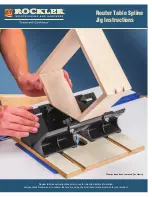
Ironwood FX 750 | User Manual
20
8.5 Positioning and Using Collars
When shaping with collars, the collar must have sufficient bearing
surface. Also, the workpiece must be fairly heavy relative to the cut
being made.
The collars may be used above, below, or between the cutters.
Under no circumstances should you shape a short or light work
piece against the collars.
When the collar is used below the cutter, the progress of the cut can
be seen throughout the operation. However, any accidental lifting of
the workpiece will gouge the product and ruin the workpiece.
When the collar is used above the cutter, the cut cannot be seen,
but this method offers an advantage: the cut is not affected by light
variations in the thickness of the workpiece. Also, accidental lifting
of the workpiece will not gouge the work piece; simply repeat the
operation to correct the mistake.
Using the collar between two cutters has advantages and
disadvantages of the first two procedures, and is frequently used
where both edges of the work are to be molded.
Note: Place the cutter as low as possible on the spindle to reduce
spindle deflection and ensure the best possible finish. Also, make
sure that the contacting surfaces of the cutter are smooth, clean,
and without dents.
Table
Cutter
Collar
Workpiece
Collar below cutter:
the progress of the cut
can be seen throughout
the operation.
Table
Collar
Cutter
Workpiece
Be sure there’s enough
bearing surface and that
the workpiece is not too
short and light.
Insufficient
bearing surface
Workpiece
is too small
WRONG
Cutter
Cutter
Collar between two
cutters: used where
both edges are to be
molded
Collar
8.6 Tenoning
WaRninG
Keep guards in place and in working order.
The miter gauge and clamp provided with the machine can be used
for tenoning operations.
If your machine is equipped with a tenoning carriage, the tenoning
hood fitted with adjustable sections is used to guard the tool from
above the workpiece and from the sides.
Various tenoning carriages are available. For more details contact
Stiles Machinery.
8.7 Tool Adjustments
WaRninG
Tools are extremely sharp. Be careful when working with tooling as
serious injury may occur.
Caution
Always disconnect the machine from its power source before
making any adjustments.
To reduce kickback, use only tools that conform to EN 848-1:2005
and EN 848-2:2001, and that are marked MAN.
Refer to the tool manufacturer’s recommendations for clamping and
setting of tools.
To ensure safe and efficient cutting, the tooling should be suitable for
the material being cut. The tools should be sharp and properly set
with carefully balanced tool holders.
Use extra precautions when handling tools and always use
tool carriers.
8.8 Noise Reduction
• Always use hearing protection.
• Make sure tooling is in proper working condition.
• Properly position material and guards.
• Use proper tooling speed.





































